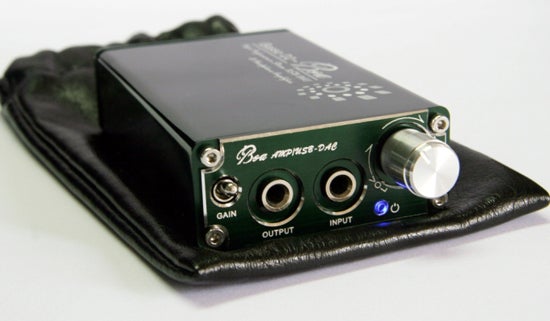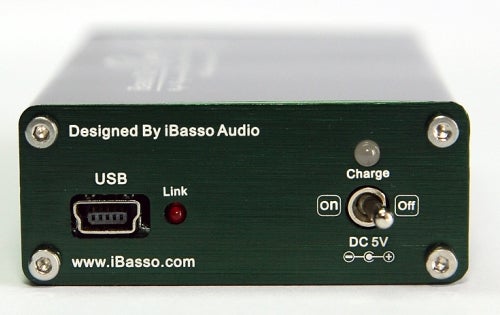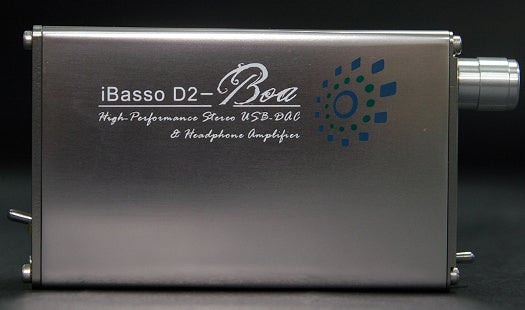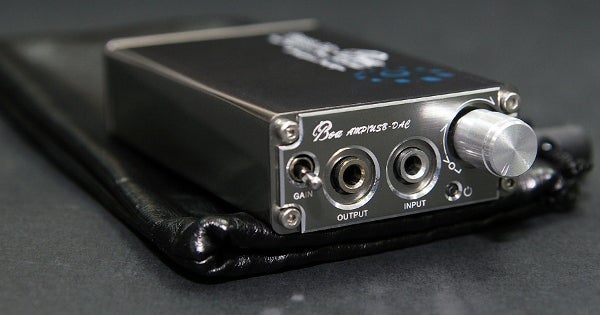iBasso D2 Boa Headphone Amplifier Review
iBasso D2 Boa Headphone Amplifier
The iBasso D2 Boa may be expensive, but you really do get what you pay for.

Verdict
Key Specifications
- Review Price: £164.95
It’s fair to say that, for many of us, a serious, separate headphone amplifier like the iBasso D2 is the kind of luxury we think we can do without. Whereas a bargain-basement device like a Cmoy amp or the much-loved FiiO E5 is pretty much an impulse purchase, you need to be serious about your audio before you splash out £150 on a pair of headphones, let alone on an amplifier to drive them. The iBasso D2, however, leaves me pondering. Sure, I could do without it, but having heard my music with it, do I want to?
Let me explain. In the Hi-Fi world, headphone amps became popular because serious headphone aficionados felt that the built-in headphone outputs sported by most mainstream amplifiers didn’t provide a signal that was clean or powerful enough to drive their favourite cans as they wanted them to be driven. A separate amplifier, tuned specifically to the needs of headphones, would provide a better result.
It was inevitable that this idea would translate to the world of PC and digital audio eventually. For one thing, the built-in amplification and output circuitry in many MP3 players doesn’t have the power or the finesse to get great results from what you might call audiophile headphones, and can introduce unwelcome noise. For another, as more of us rely on PCs and notebooks as an audio source, the same can be true of the DACs and amplifiers built into our sound cards and motherboard audio chipsets. We might be busily ripping all our CDs to FLAC or Apple Lossless, but then we end up putting them through DACs, amplifiers and outputs that colour or even denigrate the signal before it even gets a chance to reach our headphones.
Cleverly, the iBasso D2 amplifier has a solution for both problems. First, it’s a highly portable headphone amplifier, capable of taking the signal from a headphone socket or a line-level output and boosting it to suit the demands of even the most high-impedance stereo ‘phones. Secondly, it doubles as an outboard DAC and amplifier for PC and notebook use, using USB to stream the digital signal to Wolfson WM8740 and Texas Instruments PCM2706 DACs for processing and analogue conversion. You’ll find the Wolfson chip inside high-end CD players from the likes of Kenwood, Onkyo, Rega and Cambridge Audio, so it’s fair to say that you can expect a better sound than you might get from the your average integrated audio chipset.
The unit itself is a little corker, roughly the size of a cigarette packet, weighting in at 108g and clad in a hard-wearing, shiny metal casing with cool brushed-aluminium front and back plates. iBasso seems to understand that you won’t want it scratched while out on the move, so the amp comes supplied with a leather carrying pouch.
The D2 is powered by a 470mAh Lithium Polymer battery, which you can charge via the USB socket on the backplate by flicking the charge switch from ‘off’ to ‘on’. iBasso claims that the battery is good for 38 hours of continuous use, and while I’ve been too busy plugging the thing in and out of laptops, PCs and iPods to test this properly, I don’t see any reason to doubt it.
Inputs, outputs and controls are kept deliberately simple, with a 3.5mm mini-jack input and matching output on the front, along with a volume knob which doubles as an on-switch, and a ‘gain’ switch that you can set up for high-impedance headphones, and down for more sensitive cans. A single, blue LED tells you that the unit is switched on.
PC setup is equally simple. Just connect the D2 up via USB and Windows recognises it as a USB DAC and installs the necessary drivers automatically, with the D2 taking over from any integrated audio solution or soundcard. I wasn’t been able to test with a Mac or Linux system, but I understand from other users that it works perfectly well with the former, at least.
iPhone owners should also be warned that – like most headphone amps and speaker docks – the D2 is susceptible to noise interference. Switch your iPhone into airplane mode if you want to enjoy your music to the full.
To give the D2 a run, I first reached for my second-gen iPod touch and my trusty Samsung YP-Q1, then grabbed as many pairs of headphones as I could lay my hands on. Taking the signal from the headphone output of both players to the D2, there’s a definite improvement in audio quality with just about every pair of headphones I tried. The difference is less pronounced with the Q1, which runs slightly louder than the touch and has – I suspect – better output circuits, but overall you seem to get a stronger bass, clearer mids and, generally, a livelier sound when using the D2 than when relying on the player’s built-in amplification.
As you might expect, much also depends on the headphones. With a pair of Grado SR60s, you gain some benefits in terms of a bigger sound and added presence, but probably not enough to make the expense worthwhile. Switch up to the Grado SR125s, however, and there’s a more noticeable impact; even though these are still sensitive, 32Ω cans, you can appreciate the extra warmth, detail and general ‘zing’ that you get with the D2 over the stock amplification.
I found an even more impressive boost with a pair of AKG K141 studio headphones. Rated at 55Ω, they’re a little harder to drive than the Grados and can, with poor amplification, sound thin. I like them a lot for classical music and – rather oddly – vintage rock, but they’re not the most versatile set of ‘phones I have to hand. With the D2, however, they take on a new lease of life. I don’t think the D2 colours the sound or boosts the bass in the way that the FiiO E5 does, but there’s a new richness of tone in the bass and mid-range with it attached, while clarity – already a strong point of the K141s – is, if anything, enhanced.
However, the D2 also gives you another way to get a little more from your iPod. You see, the iPod’s dock connector actually provides a line-out signal, and with the correct cable or adaptor attached, you can take this directly into the D2’s input, bypassing the iPod’s amplifiers altogether. The result was something of a revelation to me.
I’ve listened to Massive Attack’s Teardrop hundreds of times through the iPod through a bewildering variety of headphones, but I’d never heard it sound this good through the Apple player, the huge bass underpinning layers of detail in the vocals, sounds and samples that I normally struggle to resolve. It’s an odd thing. I would plug in the AKGs or Grados directly into the iPod and think “Actually, that’s not bad. Maybe I’m imagining the difference.” I’d then hook up the D2, play the same tracks and think “Blimey – that’s what I’ve been missing.”
The fact is, once you’ve got used to listening to a decent pair of headphones through the D2, it’s very hard to go back. Tracks that used to sound OK suddenly sound thinner, less exuberant and less detailed.
The same holds true when you use the D2 as a combination DAC/Amplifier with a PC or notebook. The difference between the output direct from the headphone socket of my HP laptop and the output of the D2 was a lot larger than I’d anticipated. I’d listen to, for example, the opening strings and weird electronic noises on Joga from Bjork’s Homogenic and think they sounded okay. Then I’d plug in the D2 and marvel at the new levels of detail, and the way in which the dynamics of the track grow in complexity and life.
The opening bass line of The Smashing Pumpkins’ Ava Adore used to sound perfectly good through the bare headphones output, but having listened to it with the D2 hooked in, it now sounds cluttered and dull. With the Bill Evans Trio’s take on Some Day My Prince will Come from Portrait in Jazz, there’s a new lightness and spring in the sound that I hadn’t heard through the Grados before – or at least not to the same extent.
Meanwhile, the D2 seems to lend a new sense of 3D space and rich orchestral detail to the Karl Boem recording of Wagner’s Tristan and Isolde, creating a sound that could be truly epic in one breath, elegant and restrained the next. I hesitate to say that the difference is night and day, but it’s certainly close, and while best appreciated with FLAC or WMA Lossless files, it’s still apparent with 256K and 320K MP3 files and even – hurrah! – Spotify.
Before we get too carried away, I should note that the benefits aren’t so pronounced if you’re already equipped with a high-quality sound card. Switching to my desktop system with a Creative X-Fi Extreme PCI audio card installed, I’d still say that the D2 produced a warmer, richer sound with enhanced clarity and mid-range presence, but it’s a difference I’d be less inclined to pay £165 for.
If you’re a serious audiophile who has invested hundreds of pounds on headphones, then your opinion will probably differ. Don’t your HD650s or RS1s deserve better when you’re listening to your CDs?
Indeed, when compared to the competition the D2 is actually good value for money. Unfortunately I was unable to source a Graham Slee Grand Voyager for direct comparison, but while that amp is renowned for its superb sound and excellent value, it’s heavier, uses chunky 9V batteries and doesn’t include the D2’s DAC. When you consider that dedicated headphone amps can cost anywhere between £100 and several thousand pounds, the D2 does well in straight bang-for-buck terms.
Does that necessarily mean that you need one? No. If you just want to make your iPod sound better then the FiiO E5 will do the job for under £20. Or why not ditch your iPod and buy a better sounding player from Sony, Samsung or Cowon, and spend the cash you’ve saved on headphones?
If you want better audio from your PC or notebook, then a new internal or external soundcard would seem a more cost-effective solution, albeit one that won’t provide you with the same kind of quality. But trust me, ‘need’ has nothing to do with it. Find some good headphones and give the D2 a spin and you might not need one, but you’ll definitely want one. I have, and unfortunately for my bank balance, I do.
Verdict
A great sounding portable headphone amp that doubles as an outboard DAC for PC listening. Try it with the right cans, and you’ll never want to listen to your headphones without one out again.
Trusted Score
Score in detail
-
Sound Quality 9
-
Features 8
-
Value 8

